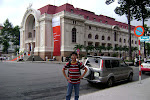 Last 21 September 1972, the late President Ferdinand Marcos issued Presidential decree 1018 which placed the country under martial law. That was nearly 36 years ago. And I was still an elementary student at Immaculate Concepcion Parish School. Gosh, that was really a long time ago! Anybody who studied in that school along Lantana Street?
Last 21 September 1972, the late President Ferdinand Marcos issued Presidential decree 1018 which placed the country under martial law. That was nearly 36 years ago. And I was still an elementary student at Immaculate Concepcion Parish School. Gosh, that was really a long time ago! Anybody who studied in that school along Lantana Street?With 1081, press freedom and other civil liberties were curtailed. I remember the image of Kit Tatad on TV reading Proclamation 1018. Congress and other media establishments were closed.
Journalists, student and labor activists, were hauled off to military compounds run by the army and the Philippine Constabulary.

But during those nights in September 1972, many families were affected by 1081 as military agents went into many households and arrested men and women whose ideas, words and beliefs were contrary to the government.
Plus, there was curfew from midnight to 4pm. And that was probably one of the better results of 1081. Crime rates plunged and there was peace and quiet in the streets. And I guess many families were happy not see the presence of criminals and hoodlums in the streets.
And I remember the Department of Tourism’s “Balikbayan” Program which brought in dollars from Filipinos living and working abroad. And Masagana 99 program.
1081 stretched for the next nine years until Marcos issued Proclamation 2045, formally ending martial law on January 17, 1981. Still, many from the opposition saw the lifting of martial law as a precondition to the visit of Pope John Paul II. An election followed in June 1981 but little believed the credibility of that political exercise.

More recently, there was a scare of martial law that Filipinos in HK made their presence felt out in the streets. Photo from AFP/Getty Images, taken last year nn the eve of the 35th anniversary of 1081.





No comments:
Post a Comment